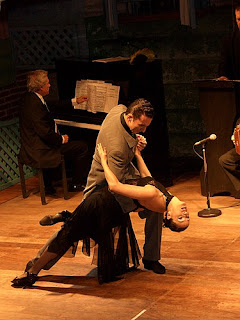There was a talk that I and a dance partner are going to demonstrate Argentine Tango, then teach Tango for about 45 minutes followed by some dance, in a wedding.
Due to schedule and other conflicts, I backed out of the gig. I am not going to do it. I suggested some others who might be able to take the gig. Hope everything works out.
This (unrealized) gig had me think about how we would have proceeded in preparation for 6 weeks.
The prospective partner does not have stage experience much, although she dances Tango in milonga and has decent basics for social Tango.
My plan. First two weeks are time for physical and mental preparation, upgrading and converting Tango moves for stage version.
That is why I planned to lecture Stage Tango 101.
(Some time ago, as a part of my Tango research, I interviewed several traveling Tango instructors [strong stage dancers/performers] on stage Tango. I planned to eventually assemble the materials as a book about doing or how to do stage tango. ...maybe later.)
Anyway, as the prospective partner was already familiar with tango basics, the initial lecture should be simple. I planned to emphasize only 5 points. (It's a lot of work, though).
#1 Forget about milonga rules.
Social Tango in milonga and stage tango performance on an open floor are two different dances. In social tango, you are to respect other dancers, including no high kicks, no passing, no going against the line of dance, no lifts, no drops, etc.
Believe or not, there rules are rather strongly engrained in social Tango dancers. Milonga-raised dancers may become good at "staying there and going around each other in small ways" moves (molinete, giro, ocho cortado, etc). But they can also develop habits of restraining widths of stride, causing little timid walk that won't do well on stage. When larger energy/momentum is applied, they can collapse. And that shouldn't happen.
Going clockwise (not "counterclockwise, along line of dance") is legal on (solo) stage.
Taking big strides means you move fast from here to there. You can do it. No worrying for traffic jam or running into other couples.
And they never kick up big. On stage, you should.
#2 Focus on how your dance look
Stage Tango is a visual art, from the standpoint of audience. In social dance, indulging in your dance feeling is fine. But on stage in performing and in demonstrating your dance for an audience, you have to prioritize the look of your dance.
One of arts close to dancing is acting. You need to learn to convey your message by your art of acting/dancing. The message is visual, when your audience is far away.
Your feeling is poor indicator of visually good dance. 90-95% of social dancers in milonga have wrong or poor postures and body alignments that do not look "trained". Correct posture can be uncomfortable at first, because you are just not used to it.
Use mirror and practice until your "feeling good" matches your "looking good".
#3 Learn to move big and fast
You are "demonstrating" moves. Your moves, as a couple, should be visible from a distance (20 feet away at least. You need to consider how far your audiences are).
#4 Learn to use big and visible embellishments
Again, don't worry about kicking others. Break the "psychological block by milonga rules" first. Focus on how you demonstrate your embellished moves.
To do high boleo and high kicks, you need to activate specific muscles in hips and/or legs. To add hesitation or styling in your walk to show your musical interpretation, you want to use ankle-foot play or some gesture moves. You need to know these moves as knowledge. Then, these moves need practice, both solo and as a couple.
This motion size and type conversion can take a long time for a dancer. The reason can be psychological and/or physical. That is why I wanted to include these points in the first lecture.
#5 Contrast in fast and slow energy flow
Dance can look boring if all moves are performed in a monotone, metronomic manner. Fast fast fast fast......predictability is an enemy of good-looking dance.
Besides, Tango music itself is a mixture of fast energy and slow energy. You dance to the music. Then you'll move with contrasted energies.
If you check out good stage dances, dancers mix up fast and slow, dynamic and deliberate. You should do it, too.
#1-#4 are already a lot of work. #5 may be a little much, but I wanted to mention it early.
Later on weeks 3-5, once the conversion started showing, we would have worked on select choreographed moves with the song (TBD).
Dance is to be with the song/music. A choreography can be danced much easier with the matching song/music.
Your body cannot lie on stage. You show what you got. That is why stage dancing can be scary.
We can tell good dancers just by their dances. You show what you got. You dancers communicate your art visually to your audience. How exhilarating.
["Choreographed Stage Tango in Buenos Aires", from wikipedia]


